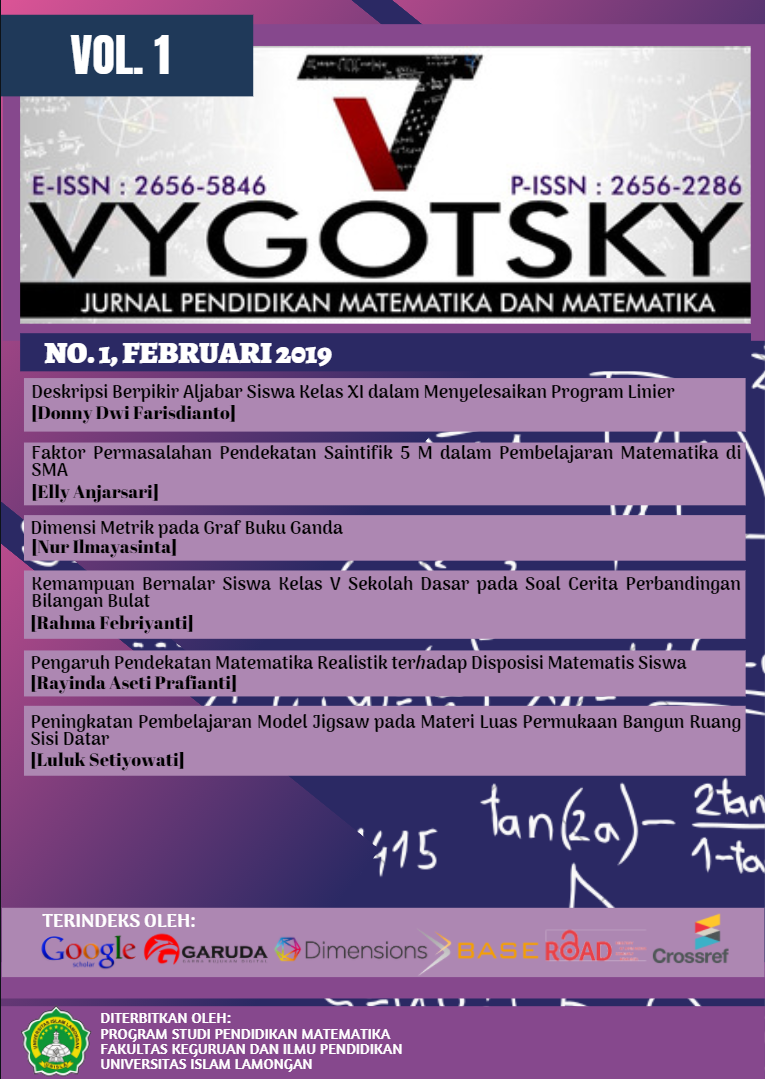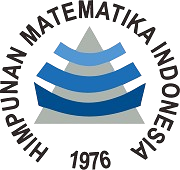Pengaruh Pendekatan Matematika Realistik Terhadap Disposisi Matematis Siswa
DOI:
https://doi.org/10.30736/vj.v1i1.91Keywords:
Pendekatan Matematika Realistik, Disposisi MatematisAbstract
Penelitian ini bertujuan untuk menelaah perbedaan disposisi matematis siswa yang memperoleh pembelajaran dengan pendekatan matematika realistik dan siswa yang memperoleh pembelajaran dengan pendekatan konvensional.Dalam penelitian ini metode yang digunakan adalah metode kuantitatif yaitu Quasi Experimental Design dengan bentuk postresponse only, nonequivalent control group design. Penelitian ini dilaksanakan disalah satu SMP Negeri di Lembang Jawa Barat. Data diperoleh dari non-tes berupa angket skala disposisi matematis. Hasil penelitian menunjukkan bahwa, disposisi
matematis siswa yang memperoleh pembelajaran dengan pendekatan matematika realistik lebih tinggi secara signifikan daripada siswa yang memperoleh pembelajaran dengan pendekatan konvensional.
Downloads
References
Ahmad Fauzan. (2003). Rute Belajar dalam RME: Suatu Arah untuk Pembelajaran Matematika. Makalah, disampaikan pada Seminar Nasional Pendidikan Matematika di Universitas Sanata Dharma Yogyakarta 27-28 Maret 2003
Bakker, A. (2004). Design Research in Statistic Education on Symbolizing and Computer Tools. Amersfoort: Wilco.
Kilpatrick, J., Swafford, J., & Findell, B. (Eds). (2001). Adding it up: Helping Children Learn Mathematics. Washington, DC: National Academy Press.
Lestari, K. E. dan Mokhammad Ridwan Yudhanegara. 2015. Penelitian Pendidikan Matematika. Bandung: PT Refika Aditama.
Maxwell, K. (2001). Positive learning dispositions in mathematics. [Online]. Available: http://www.education.auckland.ac.nz/uoa/fms/default/education/docs/word/research/foed_paper/issue11/ACE_Paper_3_Issue_11.doc. [10 Desember 2017].
National Council of Teachers of Mathematics, (1989) Curriculum and Evaluation Standards for School Mathematics, Reston, Virginia.
Putra, A. K., Budiyono, & Slamet, I. (2017, August). Mathematical disposition of hunior high school students viewed from learning styles. In AIP Conference Proceedings (Vol. 1868, No. 1, p. 050025). AIP Publishing.
Russefendi, E.T. (2010). Perkembangan Pendidikan Matematika. Jakarta: Universitas Terbuka.
Rahayu, R., & Kartono, S. The Effect of Mathematical Disposition on PMRI toward Problem Solving Ability Based on Ideal Problem Solver.
Sumarmo, U. (2006), Berfikir Matematik Tingkat Tinggi: Apa, Mengapa, dan Bagaimana Dikembangkan pada Siswa Sekolah Menengah dan Mahasiswa Calon Guru. Makalah disajikan pada Seminar Pendidikan Matematika di Jurusan Matematika FMIPA Universitas Padjadjaran Tanggal 22 April 2006: tidak diterbitkan.
Usdiyana, D., Purniati, T., Yulianti, K., & Harningsih, E. (2009). Meningkatkan kemampuan berpikir logis siswa SMP melalui pembelajaran matematika realistik. Jurnal Pengajaran MIPA, 13(1), 1-14.
Wiersma, W., & Jurs, S. G. (2005). Research methods in education: An introduction. Boston, MA: Ally and Bacon.
Downloads
Published
How to Cite
Issue
Section
License
Copyright:
Authors who publish their manuscripts in this Journal agree to the following conditions:
- Copyright of any article on Vygotsky: Jurnal Pendidikan Matematika dan Matematika is held solely by the author under the Creative Commons Attribution 4.0 International license (CC BY NC SA).
- Authors can submit papers separately, arrange non-exclusive distribution of manuscripts that have been published in this journal into other versions (e.g. sending to the author's institutional repository, publication in a book, etc.) by acknowledging that the manuscript has been published for the first time in Vygotsky: Jurnal Pendidikan Matematika dan Matematika.
License:
Vygotsky: Jurnal Pendidikan Matematika dan Matematika is published under the terms of the Creative Commons Attribution 4.0 International License (CC BY NC SA). This license permits anyone to copy and redistribute this material in any form or format, compile, modify and develop this material for any purpose as long as it is not for commercial purposes. Additionally, anyone must provide credit and distribute contributions under the license of the creator of the original work.











